Citroen C4 CACTUS RHD 2014 1.G Owner's Manual
Manufacturer: CITROEN, Model Year: 2014, Model line: C4 CACTUS RHD, Model: Citroen C4 CACTUS RHD 2014 1.GPages: 331, PDF Size: 8.56 MB
Page 171 of 331

169
In the event of a fault with the the SCR emissions control system
In the event of the detection
of a faultDuring an authorised driving phase (between
650 miles and 0 miles) (1 100 km and 0 km)
A system that prevents engine starting is
activated automatically from 650 miles
(1 100 km) after confirmation of a fault
with the SCR emissions control system.
Have the system checked by a CITROËN
dealer or a qualified workshop as soon as
possible.
If it is a temporary fault, the alert
disappears once the exhaust gas
emissions return to normal.
When switching on the ignition, the UREA,
SERVICE and diagnostic warning lamps comes
on, accompanied by an audible signal and the
display of a message "Emissions fault" to signal
a fault with the emissions control system.
If a fault with the SCR system is confirmed
(after 30 miles (50 km) covered with the
permanent display of the message signalling
a fault), when switching on the ignition, the
SERVICE and engine diagnostic warning lamps
come on and the UREA warning lamp flashes,
accompanied by an audible signal and the
display of a message (e.g.: "Emissions fault:
Starting prevented in 150 miles") indicating the
remaining range express in miles or kilometres.
While driving, the message is displayed every
30 seconds while the fault with the SCR system
persists.
You should go to a CITROËN dealer or a
qualified workshop as soon as possible.
If you fail to do this, there is a risk that you will
not be able to start your engine.
9
Practical information
Page 172 of 331
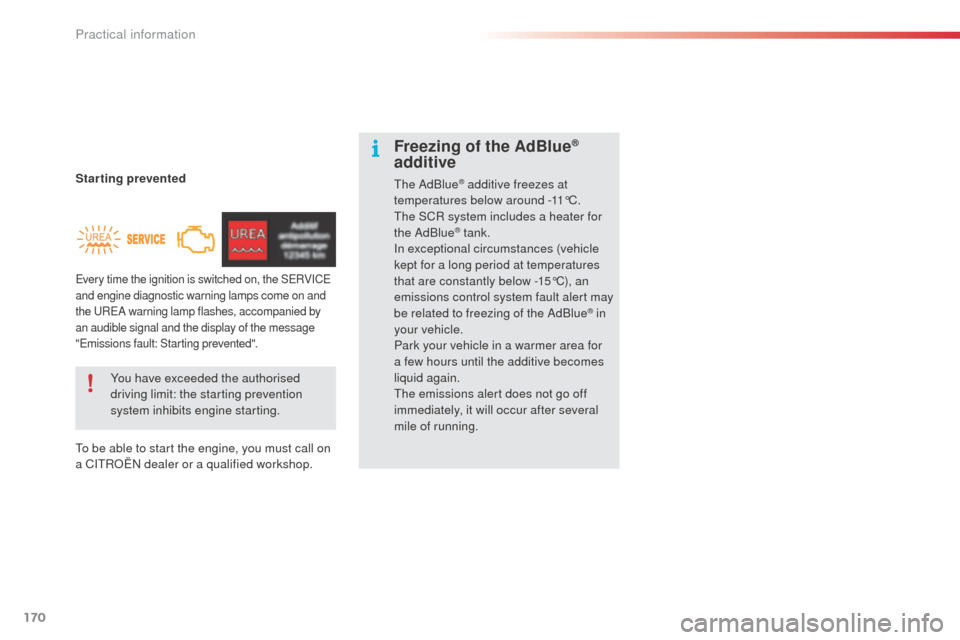
170
Starting prevented
To be able to start the engine, you must call on
a CITROËN dealer or a qualified workshop.You have exceeded the authorised
driving limit: the starting prevention
system inhibits engine starting.
Freezing of the AdBlue®
additive
The AdBlue® additive freezes at
temperatures below around -11°C.
The SCR system includes a heater for
the AdBlue
® tank.
In exceptional circumstances (vehicle
kept for a long period at temperatures
that are constantly below -15°C), an
emissions control system fault alert may
be related to freezing of the AdBlue
® in
your vehicle.
Park your vehicle in a warmer area for
a few hours until the additive becomes
liquid again.
The emissions alert does not go off
immediately, it will occur after several
mile of running.
Every time the ignition is switched on, the SERVICE
and engine diagnostic warning lamps come on and
the UREA warning lamp flashes, accompanied by
an audible signal and the display of the message
"Emissions fault: Starting prevented".
Practical information
Page 173 of 331
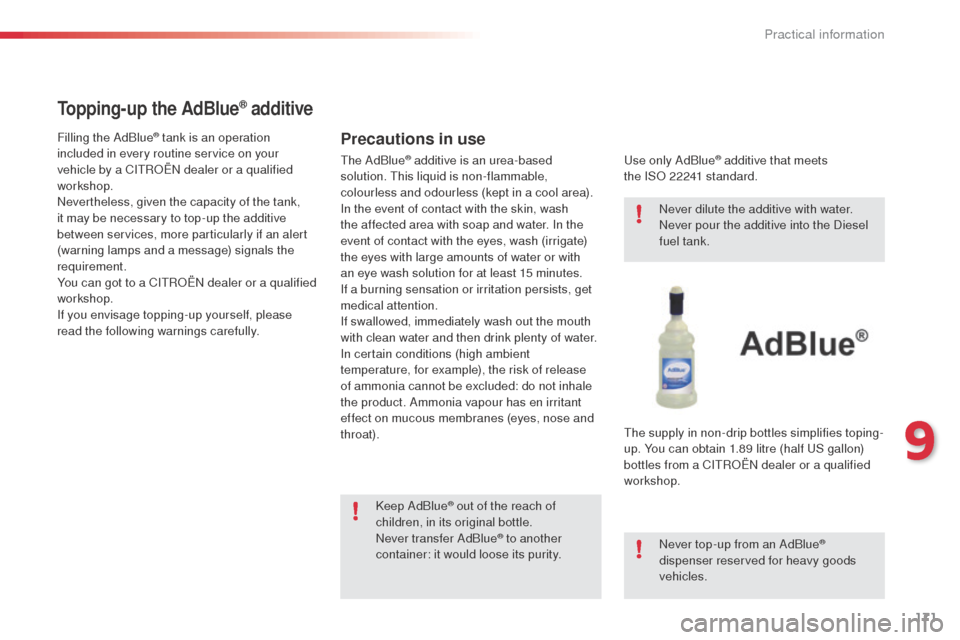
171
Topping-up the AdBlue® additive
Precautions in useFilling the AdBlue® tank is an operation
included in every routine service on your
vehicle by a CITROËN dealer or a qualified
workshop.
Nevertheless, given the capacity of the tank,
it may be necessary to top-up the additive
between services, more particularly if an alert
(warning lamps and a message) signals the
requirement.
You can got to a CITROËN dealer or a qualified
workshop.
If you envisage topping-up yourself, please
read the following warnings carefully.
Keep AdBlue
® out of the reach of
children, in its original bottle.
Never transfer AdBlue
® to another
container: it would loose its purity. Never dilute the additive with water.
Never pour the additive into the Diesel
fuel tank.
Never top-up from an AdBlue®
dispenser reserved for heavy goods
vehicles.
Use only AdBlue
® additive that meets
the ISO 22241 standard.
The supply in non-drip bottles simplifies toping-
up. You can obtain 1.89 litre (half US gallon)
bottles from a CITROËN
dealer or a qualified
workshop.
The AdBlue® additive is an urea-based
solution. This liquid is non-flammable,
colourless and odourless (kept in a cool area).
In the event of contact with the skin, wash
the affected area with soap and water. In the
event of contact with the eyes, wash (irrigate)
the eyes with large amounts of water or with
an eye wash solution for at least 15 minutes.
If a burning sensation or irritation persists, get
medical attention.
If swallowed, immediately wash out the mouth
with clean water and then drink plenty of water.
In certain conditions (high ambient
temperature, for example), the risk of release
of ammonia cannot be excluded: do not inhale
the product. Ammonia vapour has en irritant
effect on mucous membranes (eyes, nose and
throat).
9
Practical information
Page 174 of 331
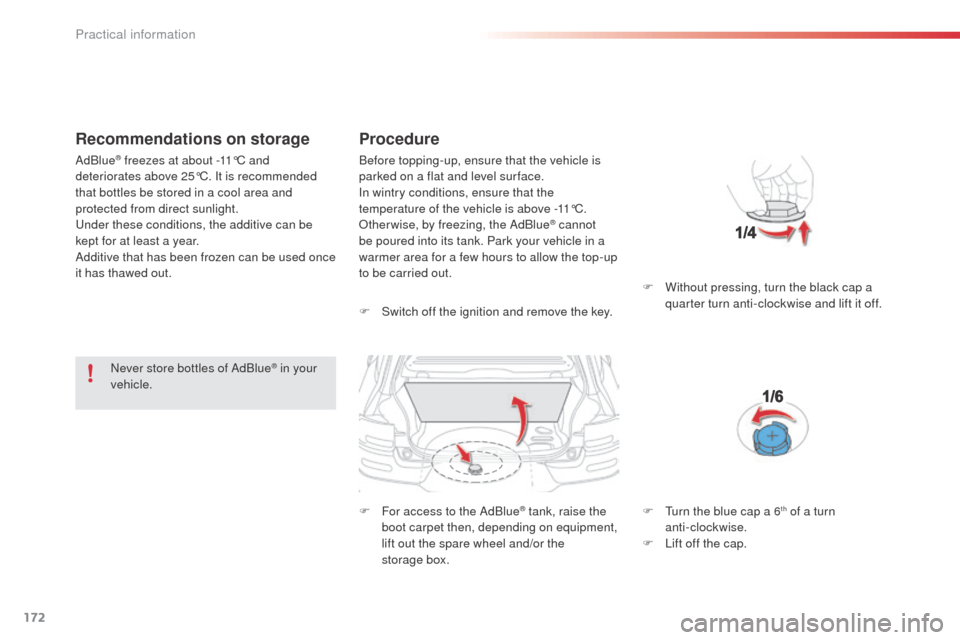
172
Recommendations on storage
Never store bottles of AdBlue® in your
vehicle.
Procedure
F Switch off the ignition and remove the key.
F
F
or access to the AdBlue
® tank, raise the
boot carpet then, depending on equipment,
lift out the spare wheel and/or the
storage
box. F
W
ithout pressing, turn the black cap a
quarter turn anti-clockwise and lift it off.
AdBlue
® freezes at about -11°C and
deteriorates above 25°C. It is recommended
that bottles be stored in a cool area and
protected from direct sunlight.
Under these conditions, the additive can be
kept for at least a year.
Additive that has been frozen can be used once
it has thawed out. Before topping-up, ensure that the vehicle is
parked on a flat and level sur face.
In wintry conditions, ensure that the
temperature of the vehicle is above -11°C.
Otherwise, by freezing, the AdBlue
® cannot
be poured into its tank. Park your vehicle in a
warmer area for a few hours to allow the top-up
to be carried out.
F
T
urn the blue cap a 6
th of a turn
anti-clockwise.
F
L
ift off the cap.
Practical information
Page 175 of 331
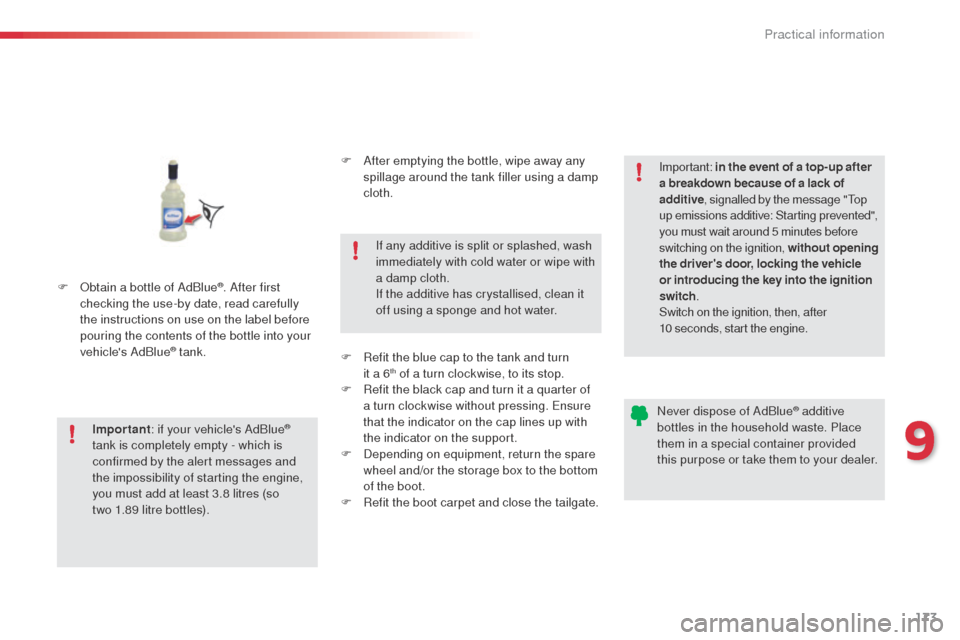
173
F Obtain a bottle of AdBlue®. After first
checking the use-by date, read carefully
the instructions on use on the label before
pouring the contents of the bottle into your
vehicle's AdBlue
® tank.
Important : if your vehicle's AdBlue
®
tank is completely empty - which is
confirmed by the alert messages and
the impossibility of starting the engine,
you must add at least 3.8 litres (so
two 1.89 litre bottles). If any additive is split or splashed, wash
immediately with cold water or wipe with
a damp cloth.
If the additive has crystallised, clean it
off using a sponge and hot water.
Important:
in the event of a top-up after
a breakdown because of a lack of
additive , signalled by the message "Top
up emissions additive: Starting prevented",
you must wait around 5 minutes before
switching on the ignition, without opening
the driver's door, locking the vehicle
or introducing the key into the ignition
switch .
Switch on the ignition, then, after
10
seconds, start the engine.
Never dispose of AdBlue
® additive
bottles in the household waste. Place
them in a special container provided
this purpose or take them to your dealer.
F
A
fter emptying the bottle, wipe away any
spillage around the tank filler using a damp
cloth.
F
R
efit the blue cap to the tank and turn
it a 6
th of a turn clockwise, to its stop.
F
R
efit the black cap and turn it a quarter of
a turn clockwise without pressing. Ensure
that the indicator on the cap lines up with
the indicator on the support.
F
D
epending on equipment, return the spare
wheel and/or the storage box to the bottom
of the boot.
F
R
efit the boot carpet and close the tailgate.
9
Practical information
Page 176 of 331
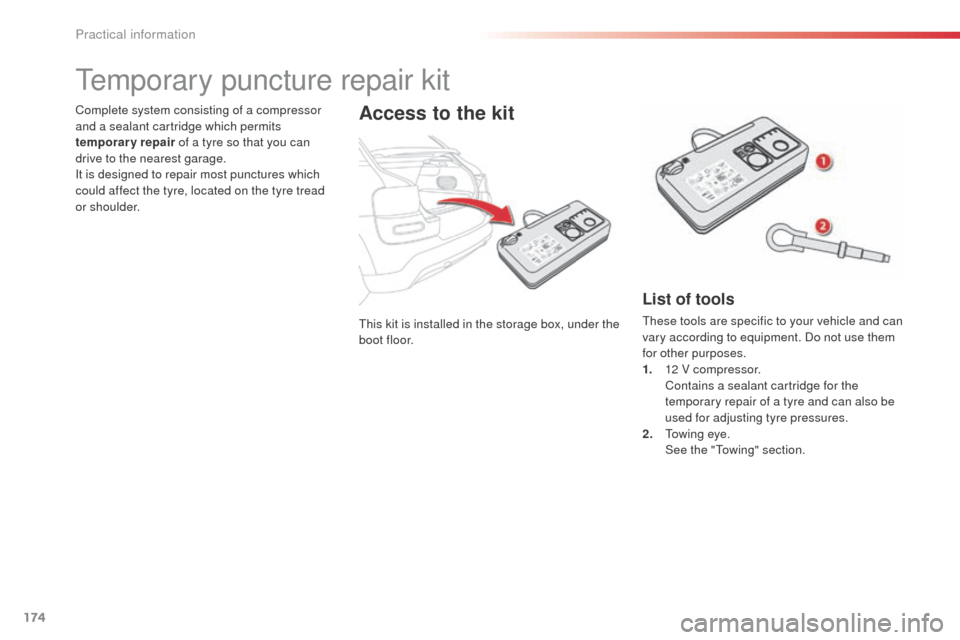
174
This kit is installed in the storage box, under the
boot floor.
Complete system consisting of a compressor
and a sealant cartridge which permits
temporary repair
of a tyre so that you can
drive to the nearest garage.
It is designed to repair most punctures which
could affect the tyre, located on the tyre tread
or shoulder.
Temporary puncture repair kit
Access to the kit
List of tools
These tools are specific to your vehicle and can
vary according to equipment. Do not use them
for other purposes.
1.
1
2 V compressor.
C
ontains a sealant cartridge for the
temporary repair of a tyre and can also be
used for adjusting tyre pressures.
2.
T
owing eye.
S
ee the "Towing" section.
Practical information
Page 177 of 331
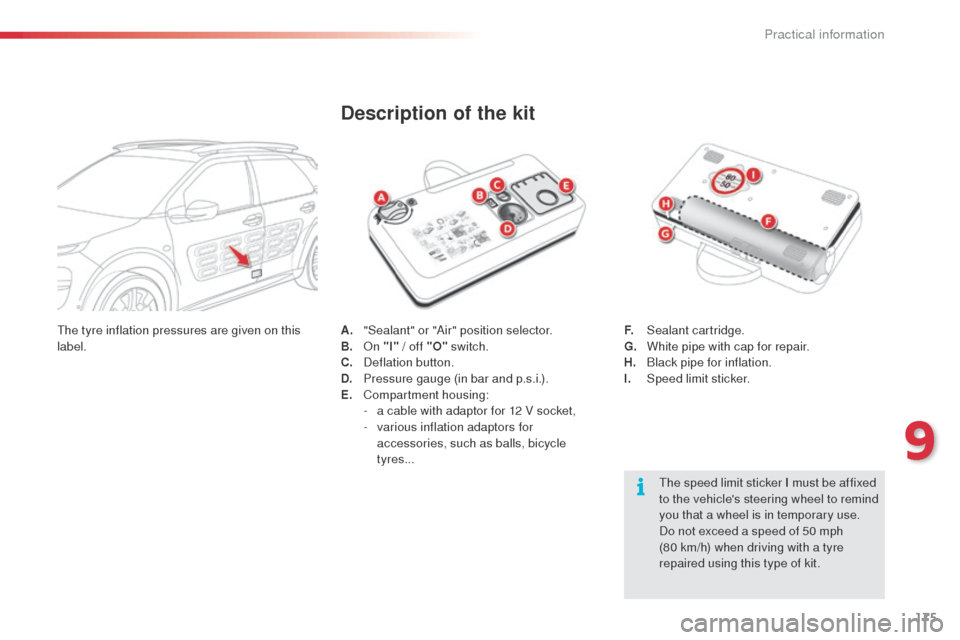
175
A. "Sealant" or "Air" position selector.
B. On "I" / off "O" switch.
C.
D
eflation button.
D.
P
ressure gauge (in bar and p.s.i.).
E.
C
ompartment housing:
-
a c
able with adaptor for 12 V socket,
-
v
arious inflation adaptors for
accessories, such as balls, bicycle
tyres...
Description of the kit
The speed limit sticker I must be affixed
to the vehicle's steering wheel to remind
you that a wheel is in temporary use.
Do not exceed a speed of 50 mph
(80 km/h) when driving with a tyre
repaired using this type of kit.
F.
S
ealant cartridge.
G.
W
hite pipe with cap for repair.
H.
B
lack pipe for inflation.
I.
Spe
ed limit sticker.
The tyre inflation pressures are given on this
label.
9
Practical information
Page 178 of 331
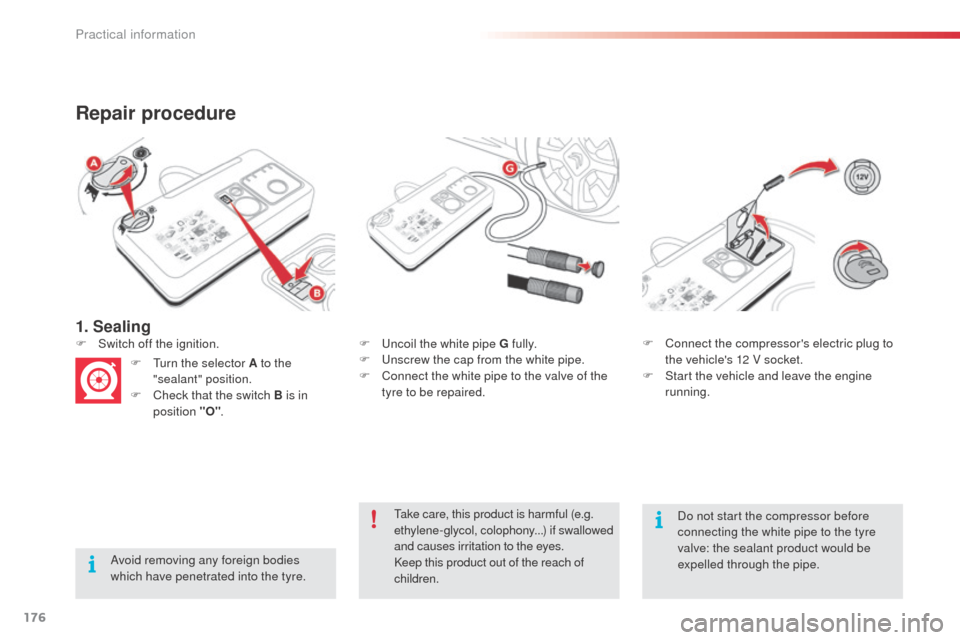
176
1. Sealing
Repair procedure
Avoid removing any foreign bodies
which have penetrated into the tyre.F
U
ncoil the white pipe G fully.
F
U
nscrew the cap from the white pipe.
F
C
onnect the white pipe to the valve of the
tyre to be repaired.
F
S
witch off the ignition.
F
T
urn the selector A to the
"sealant" position.
F
C
heck that the switch B is in
position "O" . F
C
onnect the compressor's electric plug to
the vehicle's 12 V socket.
F
S
tart the vehicle and leave the engine
running.
Take care, this product is harmful (e.g.
ethylene-glycol, colophony...) if swallowed
and causes irritation to the eyes.
Keep this product out of the reach of
children. Do not start the compressor before
connecting the white pipe to the tyre
valve: the sealant product would be
expelled through the pipe.
Practical information
Page 179 of 331
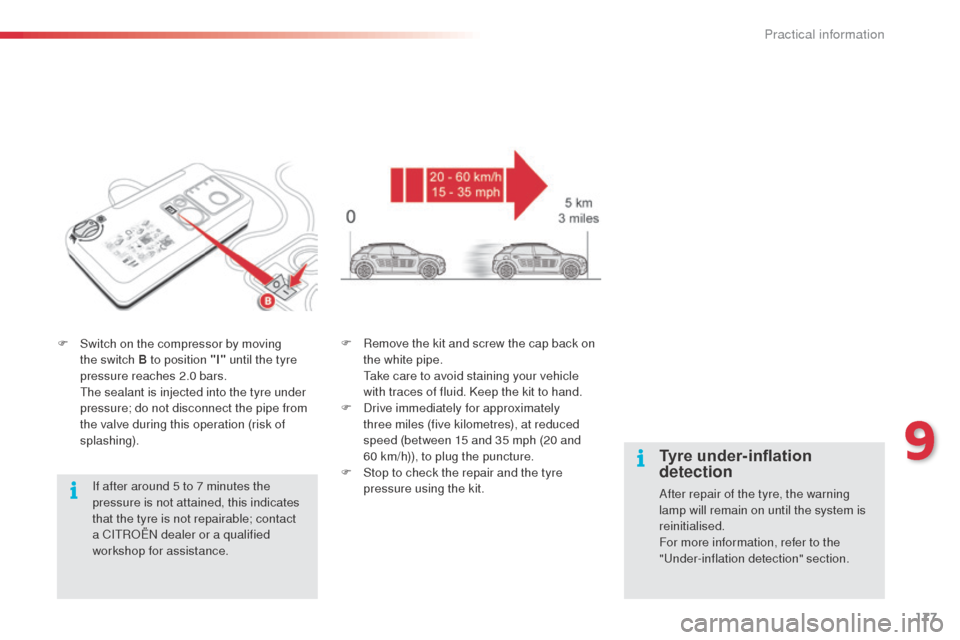
177
F Switch on the compressor by moving the switch B to position "I" until the tyre
pressure reaches 2.0 bars.
T
he sealant is injected into the tyre under
pressure; do not disconnect the pipe from
the valve during this operation (risk of
splashing).
If after around 5 to 7 minutes the
pressure is not attained, this indicates
that the tyre is not repairable; contact
a CITROËN dealer or a qualified
workshop for assistance. F
R emove the kit and screw the cap back on
the white pipe.
T
ake care to avoid staining your vehicle
with traces of fluid. Keep the kit to hand.
F
D
rive immediately for approximately
three miles (five kilometres), at reduced
speed (between 15 and 35 mph (20 and
60
km/h)), to plug the puncture.
F
S
top to check the repair and the tyre
pressure using the kit.
Tyre under-inflation
detection
After repair of the tyre, the warning
lamp will remain on until the system is
reinitialised.
For more information, refer to the
"Under-inflation detection" section.
9
Practical information
Page 180 of 331
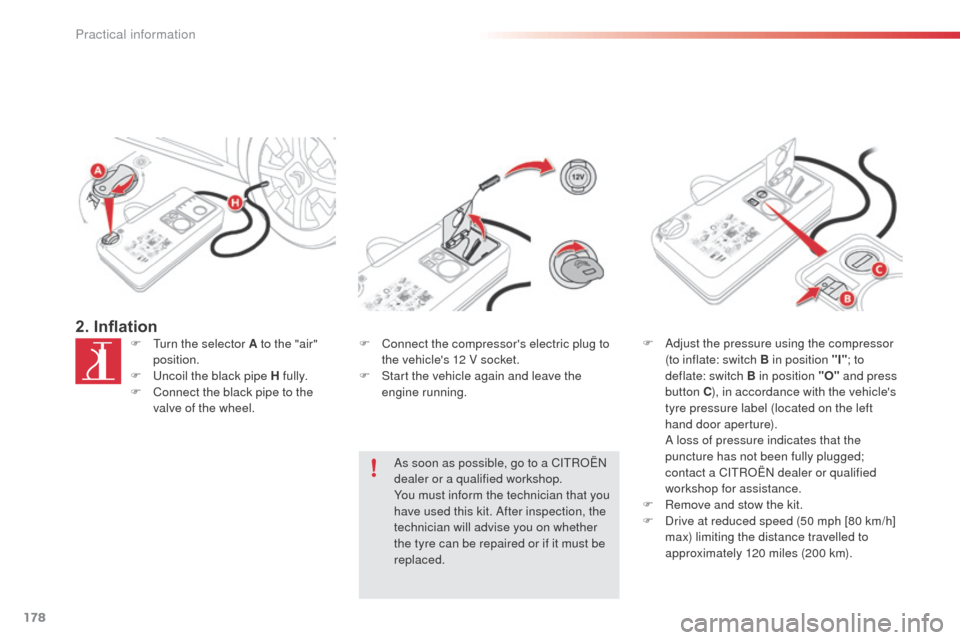
178
2. InflationF Turn the selector A to the "air" position.
F
U
ncoil the black pipe H fully.
F
C
onnect the black pipe to the
valve of the wheel. F
C onnect the compressor's electric plug to
the vehicle's 12 V socket.
F
S
tart the vehicle again and leave the
engine running.
As soon as possible, go to a CITROËN
dealer or a qualified workshop.
You must inform the technician that you
have used this kit. After inspection, the
technician will advise you on whether
the tyre can be repaired or if it must be
replaced. F
A djust the pressure using the compressor
(to inflate: switch B in position "I" ; to
deflate: switch B
in position "O" and press
button C ), in accordance with the vehicle's
tyre pressure label (located on the left
hand door aperture).
A l
oss of pressure indicates that the
puncture has not been fully plugged;
contact a CITROËN dealer or qualified
workshop for assistance.
F
R
emove and stow the kit.
F
D
rive at reduced speed (50 mph [80 km/h]
max) limiting the distance travelled to
approximately 120 miles (200 km).
Practical information